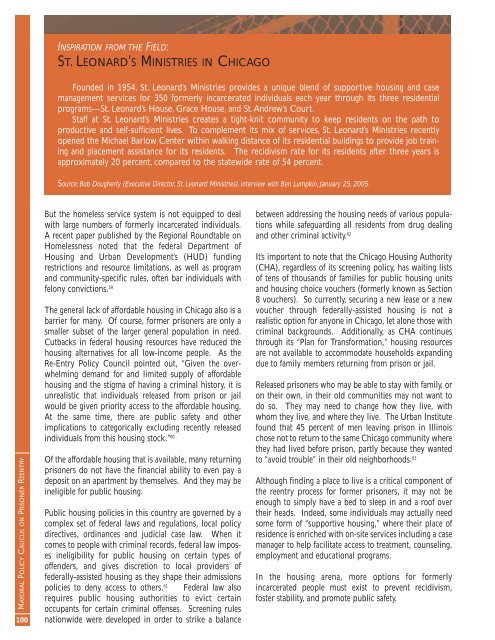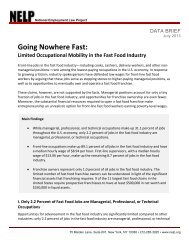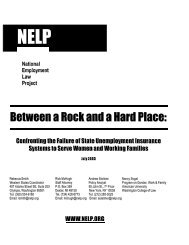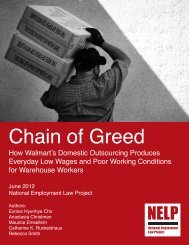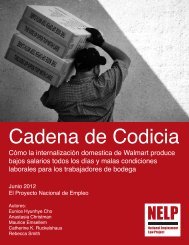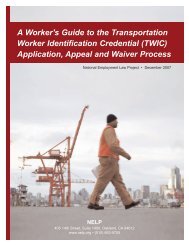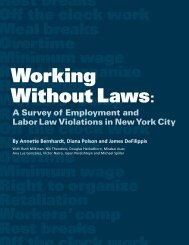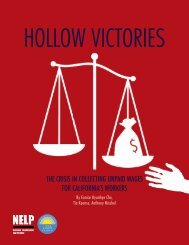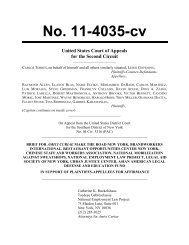Rebuilding Lives. Strengthening Communities.
Rebuilding Lives. Strengthening Communities.
Rebuilding Lives. Strengthening Communities.
Create successful ePaper yourself
Turn your PDF publications into a flip-book with our unique Google optimized e-Paper software.
INSPIRATION FROM THE FIELD:<br />
ST.LEONARD’S MINISTRIES IN CHICAGO<br />
Founded in 1954, St. Leonard’s Ministries provides a unique blend of supportive housing and case<br />
management services for 350 formerly incarcerated individuals each year through its three residential<br />
programs—St. Leonard’s House, Grace House, and St.Andrew’s Court.<br />
Staff at St. Leonard’s Ministries creates a tight-knit community to keep residents on the path to<br />
productive and self-sufficient lives. To complement its mix of services, St. Leonard’s Ministries recently<br />
opened the Michael Barlow Center within walking distance of its residential buildings to provide job training<br />
and placement assistance for its residents. The recidivism rate for its residents after three years is<br />
approximately 20 percent, compared to the statewide rate of 54 percent.<br />
Source: Bob Dougherty (Executive Director, St. Leonard Ministries), interview with Ben Lumpkin, January 25, 2005.<br />
MAYORAL POLICY CAUCUS ON PRISONER REENTRY<br />
100<br />
But the homeless service system is not equipped to deal<br />
with large numbers of formerly incarcerated individuals.<br />
A recent paper published by the Regional Roundtable on<br />
Homelessness noted that the federal Department of<br />
Housing and Urban Development’s (HUD) funding<br />
restrictions and resource limitations, as well as program<br />
and community-specific rules, often bar individuals with<br />
felony convictions. 59<br />
The general lack of affordable housing in Chicago also is a<br />
barrier for many. Of course, former prisoners are only a<br />
smaller subset of the larger general population in need.<br />
Cutbacks in federal housing resources have reduced the<br />
housing alternatives for all low-income people. As the<br />
Re-Entry Policy Council pointed out, “Given the overwhelming<br />
demand for and limited supply of affordable<br />
housing and the stigma of having a criminal history, it is<br />
unrealistic that individuals released from prison or jail<br />
would be given priority access to the affordable housing.<br />
At the same time, there are public safety and other<br />
implications to categorically excluding recently released<br />
individuals from this housing stock.” 60<br />
Of the affordable housing that is available, many returning<br />
prisoners do not have the financial ability to even pay a<br />
deposit on an apartment by themselves. And they may be<br />
ineligible for public housing.<br />
Public housing policies in this country are governed by a<br />
complex set of federal laws and regulations, local policy<br />
directives, ordinances and judicial case law. When it<br />
comes to people with criminal records, federal law imposes<br />
ineligibility for public housing on certain types of<br />
offenders, and gives discretion to local providers of<br />
federally-assisted housing as they shape their admissions<br />
policies to deny access to others. 61 Federal law also<br />
requires public housing authorities to evict certain<br />
occupants for certain criminal offenses. Screening rules<br />
nationwide were developed in order to strike a balance<br />
between addressing the housing needs of various populations<br />
while safeguarding all residents from drug dealing<br />
and other criminal activity. 62<br />
It’s important to note that the Chicago Housing Authority<br />
(CHA), regardless of its screening policy, has waiting lists<br />
of tens of thousands of families for public housing units<br />
and housing choice vouchers (formerly known as Section<br />
8 vouchers). So currently, securing a new lease or a new<br />
voucher through federally-assisted housing is not a<br />
realistic option for anyone in Chicago, let alone those with<br />
criminal backgrounds. Additionally, as CHA continues<br />
through its “Plan for Transformation,” housing resources<br />
are not available to accommodate households expanding<br />
due to family members returning from prison or jail.<br />
Released prisoners who may be able to stay with family, or<br />
on their own, in their old communities may not want to<br />
do so. They may need to change how they live, with<br />
whom they live, and where they live. The Urban Institute<br />
found that 45 percent of men leaving prison in Illinois<br />
chose not to return to the same Chicago community where<br />
they had lived before prison, partly because they wanted<br />
to “avoid trouble” in their old neighborhoods. 63<br />
Although finding a place to live is a critical component of<br />
the reentry process for former prisoners, it may not be<br />
enough to simply have a bed to sleep in and a roof over<br />
their heads. Indeed, some individuals may actually need<br />
some form of “supportive housing,” where their place of<br />
residence is enriched with on-site services including a case<br />
manager to help facilitate access to treatment, counseling,<br />
employment and educational programs.<br />
In the housing arena, more options for formerly<br />
incarcerated people must exist to prevent recidivism,<br />
foster stability, and promote public safety.


